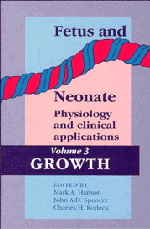12 - Measurement of human fetal growth
from Part III - Clinical applications
Published online by Cambridge University Press: 04 August 2010
Summary
Introduction
Perinatal mortality and morbidity are linked not only to gestational age but also to fetal growth. The antenatal recognition of intrauterine growth retardation (IUGR) is therefore one of the primary aims of obstetric care. However, for years clinicians have confused size with growth. Size is an endpoint, typically weight at birth, whereas growth is the process by which this endpoint is reached. Size is determined by a combination of local factors in tissues and organs, together with systemic nutritional and endocrine factors. Genetic influences, which are the primary determinant of fetal size, probably act primarily at the local level. Systemic factors are, in a sense, secondary, because although they might direct the growth process they do not determine size other than at pathological extremes (Chard, 1989).
Ultrasound is the most accurate method of determining fetal gestational age and size. Thus clinical suspicion of abnormal fetal size should prompt ultrasound assessment. Reference standards for a variety of fetal biometric measurements exist. These are derived from cross-sectional studies in a ‘representative’ population of fetuses. Using appropriate standards, biometric measurements can be classified as appropriate-, small-, or large-for-gestational age. Assessment of fetal growth requires an assessment of the change in fetal size over time and therefore requires at least two measurements of fetal size. Reference standards for fetal growth can only be derived from serial biometric measurements.
This chapter discusses the ultrasound methods used to determine fetal size and the value of serial measurements in assessing fetal growth.
- Type
- Chapter
- Information
- Fetus and Neonate: Physiology and Clinical Applications , pp. 297 - 326Publisher: Cambridge University PressPrint publication year: 1995
- 2
- Cited by



